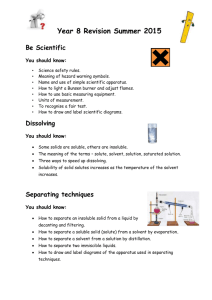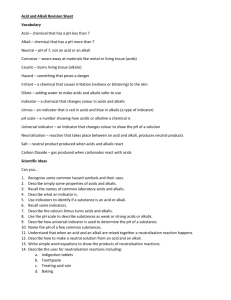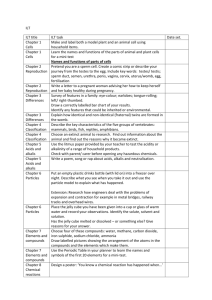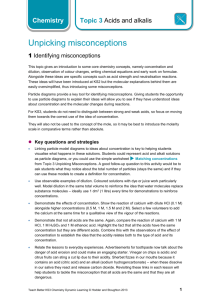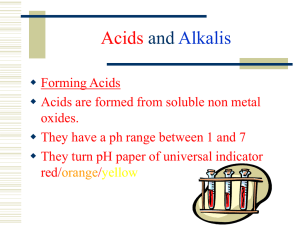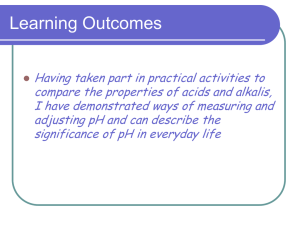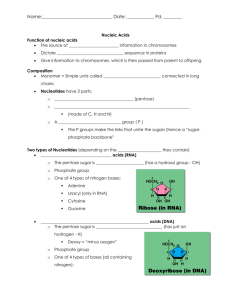Acids and alkalis: Preparing to teach
advertisement
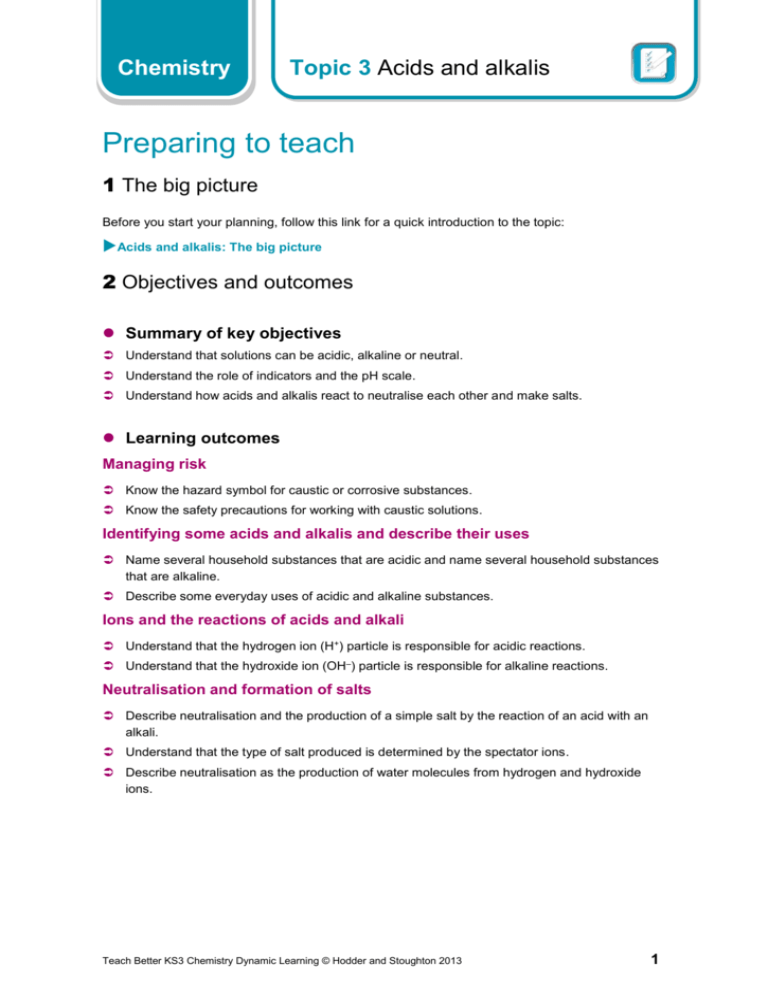
Chemistry Topic 3 Acids and alkalis Preparing to teach 1 The big picture Before you start your planning, follow this link for a quick introduction to the topic: Acids and alkalis: The big picture 2 Objectives and outcomes Summary of key objectives Understand that solutions can be acidic, alkaline or neutral. Understand the role of indicators and the pH scale. Understand how acids and alkalis react to neutralise each other and make salts. Learning outcomes Managing risk Know the hazard symbol for caustic or corrosive substances. Know the safety precautions for working with caustic solutions. Identifying some acids and alkalis and describe their uses Name several household substances that are acidic and name several household substances that are alkaline. Describe some everyday uses of acidic and alkaline substances. Ions and the reactions of acids and alkali Understand that the hydrogen ion (H+) particle is responsible for acidic reactions. Understand that the hydroxide ion (OH–) particle is responsible for alkaline reactions. Neutralisation and formation of salts Describe neutralisation and the production of a simple salt by the reaction of an acid with an alkali. Understand that the type of salt produced is determined by the spectator ions. Describe neutralisation as the production of water molecules from hydrogen and hydroxide ions. Teach Better KS3 Chemistry Dynamic Learning © Hodder and Stoughton 2013 1 Chemistry • Topic 3 • Acids and alkalis pH and indicators Use indicator colours to classify solutions as acid, alkaline or neutral. Know the colour changes for common indicators. Use an indicator colour chart to measure pH. Know pH 7 is a neutral solution, a pH of less than 7 is an acidic solution and a pH of more than 7 is an alkaline solution. 3 Teaching strategies Avoid describing acids as strong and weak acids. These terms are to do with dissociation of acid species (studied later). It is better always to refer to concentrated and dilute acid solutions, or to the pH value of the solution when this idea has been established. There are a lot of new concepts for students in this topic. Take care with the following points. Safety When working with acids and alkalis students need to be aware of the hazards and safety precautions, which requires knowledge and understanding of how acids and alkalis can be neutralised safely. Chemicals in everyday life Students need to be able to apply scientific ideas to common substances, for example lemonade, soap and washing soda. Emphasise that these have the properties of chemical substances as well as being everyday items. Vocabulary Emphasise the difference in meaning between words in common English usage and the same words in precise scientific use: acid, neutralisation, corrosive, concentrated, dilute, salt. When new terms are introduced, such as ion or molecule, show how they are used in a specific context. Particle model/kinetic theory Reinforce students’ thinking about the behaviour of particles in solution. This requires students to ‘forget’ the solvent particles and focus on the active species. Encourage students to use a particle model when thinking about making new substances at a particle level, for example in understanding the hydrogen ion/hydroxide ion reaction to create a water molecule. Include in the model the movement of particles and the first notions of collision theory of reactions. Introduce the idea that water molecules made in the reaction between an acid and an alkali are then lost into the mass of solvent. Rehearse and practise the idea of ion pairs forming new substances – practise the naming of ‘spectator particles’ that form the salt. pH scale Introduce with care the tricky concept of the pH scale. As it is a logarithmic scale, the concept is beyond most KS3 students. Some ‘model’ for this needs to be established – explain that the pH scale used to describe acidic activity in a solution works in the same way as the seismic scale used to describe the activity of earthquakes. Teach Better KS3 Chemistry Dynamic Learning © Hodder and Stoughton 2013 2 Chemistry • Topic 3 • Acids and alkalis Using indicators Indicators changing colour is a simple concrete concept that all students can see and understand easily. That is why most of the practical work for this topic uses the properties of indicators to show the progress of the otherwise invisible reactions in the solution. Make sure you emphasise that the indicator colour change is only an ‘indicator’ of what is happening with the acid and alkali particles interacting in solution. Emphasise that the indicator does not take part in the reaction or make the reaction happen. It only shows the progress of the reaction. Suggestions for further reading BBC Bitesize: Acids and alkalis www.bbc.co.uk/schools/teachers/ks3bitesize/science/acidsandalkalis.shtml Lesson plan for teachers and worksheet. Video and resources based on Acids and Alkalis Scientific Eye video www.tes.co.uk/teaching-resource/Scientific-eye-acids-and-alkalis-video-questions6039567/ The video is on acids and alkalis. The questions that go with the video are almost all one word answers. They are in a chronological order. Nuffield Practical Chemistry: How do acids and alkalis react? www.nuffieldfoundation.org/practical-chemistry/how-do-acids-and-alkalis-react This activity links the neutralisation of an acid by an alkali to the changes in ionic concentrations that result from the reaction between hydrogen ions and hydroxide ions. YouTube video: Strong and Weak Acids and Bases – this also has forward links to further videos. www.youtube.com/watch?v=u5mNk1CEpDg Models or analogy This illustration makes a useful model for dealing with a particle model for acids and alkalis. Teach Better KS3 Chemistry Dynamic Learning © Hodder and Stoughton 2013 3 Chemistry • Topic 3 • Acids and alkalis 4 Prior knowledge and links to KS4 Prior knowledge (KS2) KS3 content >>> Solids can dissolve and form solutions Some changes are reversible, such as melting and freezing Some changes result in the formation of new materials. This kind of change is difficult to reverse Changes resulting from chemical reactions cannot be reversed, such as fizz reactions, and other reactions in cooking KS4 >>>>> Particles topic Kinetic theory of matter Solutions topic Later KS3 Reactions of acids with bases, metals and carbonates >>>>>>> Patterns in the reactions of acids and alkalis Reactions of bases Heat of neutralisation Reaction kinetics Volumetric analysis Molarity and calculations Strong and weak acids – dissociation 5 Safety considerations Concentrated acids and alkalis will cause severe injuries and tissue damage. Less concentrated solutions of acids tend to toughen and harden skin, like the tanning of leather with tannic acid. This still kills the skin cells, leading to injury. On the other hand alkalis tend to ‘saponify’ the grease in human flesh. This softens the flesh and makes if slough off the underlying tissue. The resulting injury can often be worse and more difficult to treat than a mild acid injury. The immediate action for any acid or alkali in contact with flesh is to wash the area with lots and lots of cold water. It is very important that all acids and alkaline solutions used in schools and colleges should be marked with corrosive hazard labels on their container at all times. You cannot usually visually distinguish between a dilute and concentrated solution, so assume the worst case at all times. Teach Better KS3 Chemistry Dynamic Learning © Hodder and Stoughton 2013 4 Chemistry • Topic 3 • Acids and alkalis 6 Making it real and relevant Taste In dilute solutions that will not cause injury, acids taste sour and alkalis taste and feel soapy. Toothpaste contains alkalis, so to mask the unpleasant soapy taste, toothpaste has very strong flavours such as peppermint added to it. Many foods use dilute acids (e.g. vinegar, lemon juice) to bring out the flavour. Soil testing Anybody growing plants seriously, whether in a garden or on a large scale, needs to test the pH of the soil. If the pH is not right for the plants the gardener wants, then substances must be added to the soil. To test soil pH, a sample of soil is shaken with water and left to settle. The solution produced is tested with a coloured indicator. Beech and honeysuckle need an alkaline soil to grow. Cranberries and heather need an acidic soil. Treating stings Kitchen chemicals can be used for treating stings: vinegar for wasps, ‘bicarb’ for bees. Wasp stings are an alkaline substance. The best treatment is to apply a swab soaked in vinegar (ethanoic acid) to the wasp sting. This neutralises the alkaline sting and reduces the pain. Bee stings are acidic substances. A swab soaked in the mild alkali sodium hydrogencarbonate (bicarbonate of soda) will reduce the pain by neutralising the bee sting. Teach Better KS3 Chemistry Dynamic Learning © Hodder and Stoughton 2013 5

